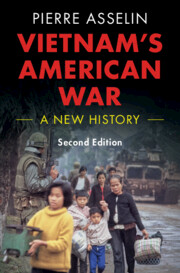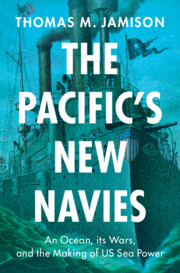Refine search
Actions for selected content:
15401 results in Military history
Acknowledgments
-
- Book:
- The Pacific's New Navies
- Published online:
- 05 December 2024
- Print publication:
- 12 December 2024, pp ix-x
-
- Chapter
- Export citation
7 - The Sino-Japanese War and New “Yankees” in the Pacific
-
- Book:
- The Pacific's New Navies
- Published online:
- 05 December 2024
- Print publication:
- 12 December 2024, pp 152-174
-
- Chapter
- Export citation
Introduction
-
- Book:
- The Pacific's New Navies
- Published online:
- 05 December 2024
- Print publication:
- 12 December 2024, pp 1-15
-
- Chapter
- Export citation

Vietnam's American War
- A New History
-
- Published online:
- 05 December 2024
- Print publication:
- 13 June 2024
-
- Textbook
- Export citation

The Pacific's New Navies
- An Ocean, its Wars, and the Making of US Sea Power
-
- Published online:
- 05 December 2024
- Print publication:
- 12 December 2024
Contents
-
- Book:
- The Cambridge History of the Vietnam War
- Published online:
- 02 January 2025
- Print publication:
- 28 November 2024, pp vii-ix
-
- Chapter
- Export citation
17 - Domestic Politics in the Democratic Republic of Vietnam, 1963–1968
- from Part II - Homefronts
-
-
- Book:
- The Cambridge History of the Vietnam War
- Published online:
- 02 January 2025
- Print publication:
- 28 November 2024, pp 365-381
-
- Chapter
- Export citation
21 - Environmental Legacies of the Vietnam War
- from Part III - Legacies
-
-
- Book:
- The Cambridge History of the Vietnam War
- Published online:
- 02 January 2025
- Print publication:
- 28 November 2024, pp 476-495
-
- Chapter
- Export citation
5 - Saigon War Politics, 1968–1975
- from Part I - The Late Vietnam War
-
-
- Book:
- The Cambridge History of the Vietnam War
- Published online:
- 02 January 2025
- Print publication:
- 28 November 2024, pp 117-140
-
- Chapter
- Export citation
7 - The Vietnam War and the Regional Context
- from Part I - The Late Vietnam War
-
-
- Book:
- The Cambridge History of the Vietnam War
- Published online:
- 02 January 2025
- Print publication:
- 28 November 2024, pp 163-188
-
- Chapter
- Export citation
23 - The Vietnam War in Vietnamese Official and Personal Memory
- from Part III - Legacies
-
-
- Book:
- The Cambridge History of the Vietnam War
- Published online:
- 02 January 2025
- Print publication:
- 28 November 2024, pp 516-532
-
- Chapter
- Export citation
3 - Hồ Chí Minh and the Rise of the Vietnamese Communist Party
- from Part I - Empires, Nations, and Revolutions
-
-
- Book:
- The Cambridge History of the Vietnam War
- Published online:
- 02 January 2025
- Print publication:
- 28 November 2024, pp 66-83
-
- Chapter
- Export citation
Maps
-
- Book:
- The Cambridge History of the Vietnam War
- Published online:
- 02 January 2025
- Print publication:
- 28 November 2024, pp xii-xii
-
- Chapter
- Export citation
8 - Moscow, Beijing, and Détente
- from Part I - The Late Vietnam War
-
-
- Book:
- The Cambridge History of the Vietnam War
- Published online:
- 02 January 2025
- Print publication:
- 28 November 2024, pp 189-206
-
- Chapter
- Export citation
16 - Building Socialism in North Vietnam after Geneva
- from Part III - The Two Vietnams
-
-
- Book:
- The Cambridge History of the Vietnam War
- Published online:
- 02 January 2025
- Print publication:
- 28 November 2024, pp 347-367
-
- Chapter
- Export citation
10 - The Second Civil War, 1973–1975
- from Part I - The Late Vietnam War
-
-
- Book:
- The Cambridge History of the Vietnam War
- Published online:
- 02 January 2025
- Print publication:
- 28 November 2024, pp 233-253
-
- Chapter
- Export citation
13 - Vietnam after “Liberation”
- from Part II - The Postwar Era
-
-
- Book:
- The Cambridge History of the Vietnam War
- Published online:
- 02 January 2025
- Print publication:
- 28 November 2024, pp 299-312
-
- Chapter
- Export citation
Part I - The Late Vietnam War
-
- Book:
- The Cambridge History of the Vietnam War
- Published online:
- 02 January 2025
- Print publication:
- 28 November 2024, pp 21-296
-
- Chapter
- Export citation
24 - The Vietnam War in American Culture
- from Part III - Legacies
-
-
- Book:
- The Cambridge History of the Vietnam War
- Published online:
- 02 January 2025
- Print publication:
- 28 November 2024, pp 533-560
-
- Chapter
- Export citation
Tables
-
- Book:
- The Cambridge History of the Vietnam War
- Published online:
- 02 January 2025
- Print publication:
- 28 November 2024, pp xiii-xiii
-
- Chapter
- Export citation
